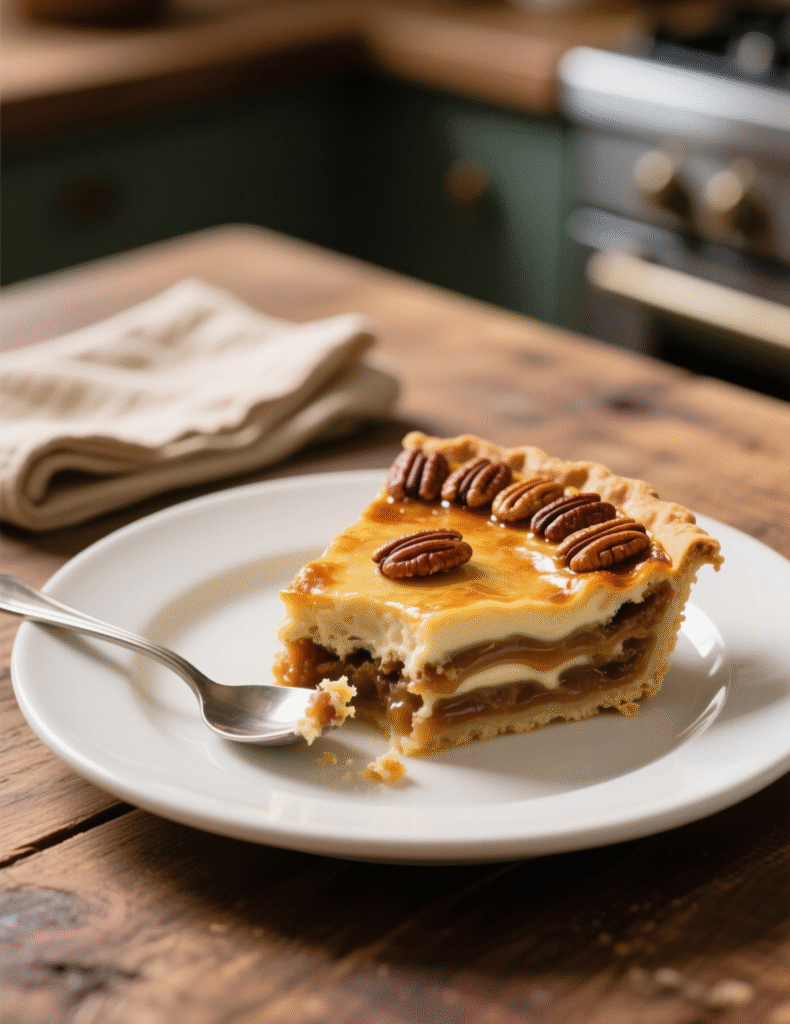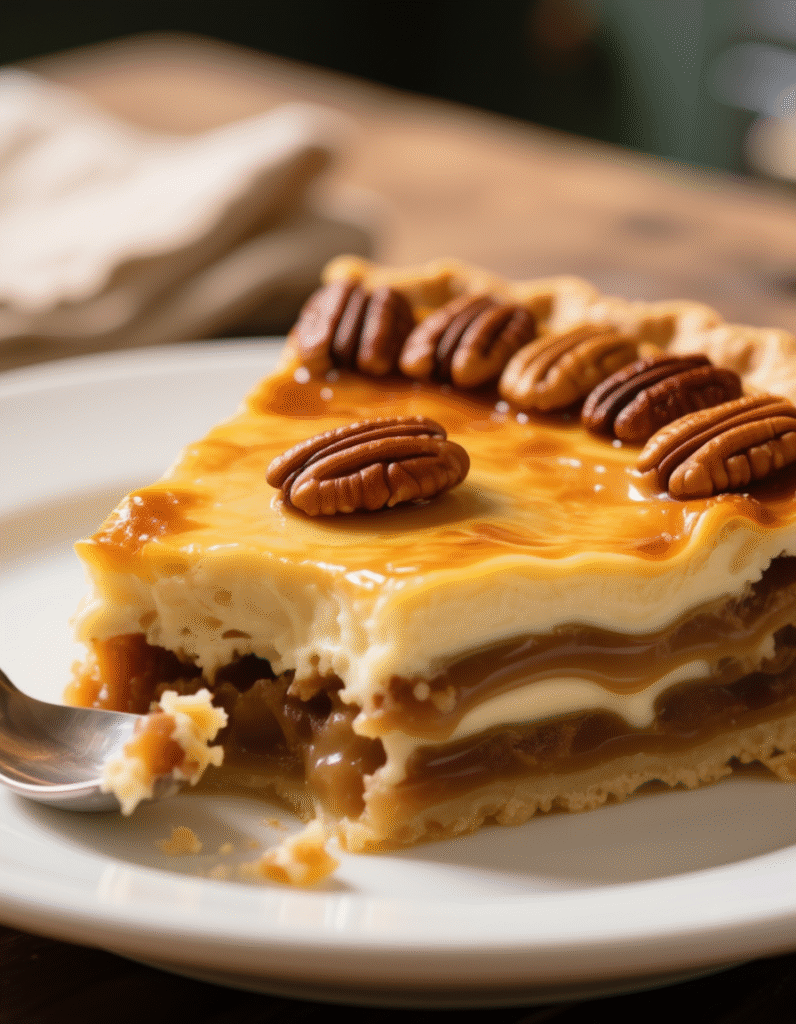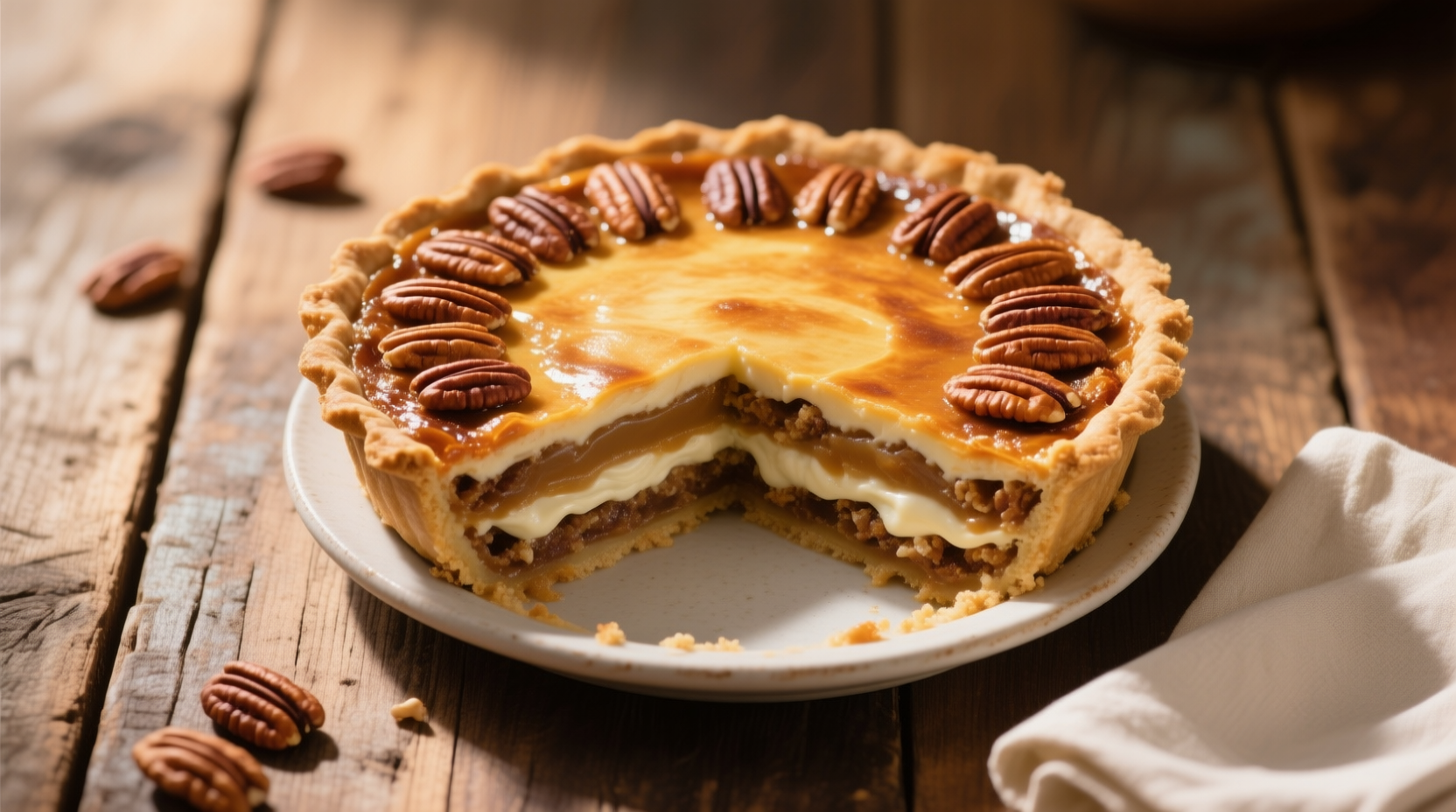Pecan pie lasagna is not your grandmother’s pecan pie, nor is it a simple layered dessert. It’s a structural marvel of pastry and filling, a textural story told in stacked layers of cream, caramel, and nuts. When executed correctly, it bridges the tradition of Southern pecan pie with the architecture of Italian-style lasagna—sweet, buttery, and dense enough to hold a fork upright. This dish isn’t just dessert; it’s edible engineering, and it deserves a seat at any professional kitchen’s table.
Why Pecan Pie Lasagna Exists at All
The world didn’t need another pecan pie. But it craved something with height, drama, and indulgence layered in increments. Traditional pecan pie delivers sweetness in one dimension—sticky filling, pastry crust, toasted pecans. Pecan pie lasagna amplifies that into four or five dimensions, stacking crust with creamy fillings, whipped mascarpone or cream cheese blends, crushed cookies, and the crown jewel: a pecan pie-inspired topping that clings like syrup on a winter morning.
Cooks began experimenting with pecan pie lasagna recipes sometime in the early 2010s, when “dessert lasagnas” first started appearing in food blogs. Oreo lasagna, pumpkin lasagna, even strawberry shortcake lasagna took their turns. But pecan pie lasagna lingered longer. Why? Because pecans are deeply tied to Southern tradition, and when you layer them with cream, caramel, and buttery cookies, you’re not innovating—you’re reinforcing nostalgia with a fresh trick.
Core Components of the Dish
At its heart, pecan pie lasagna consists of four key components:
- Crust base – Often made from graham crackers, shortbread cookies, or even Biscoff. Professionals know shortbread gives the most buttery stability, while graham offers rustic charm.
- Cream cheese or mascarpone layer – Whipped until light, but never loose, this balances the sweetness with tang and body.
- Pudding or custard middle – Many versions use vanilla or butterscotch pudding mixes, though pastry chefs prefer homemade custards for better depth.
- Pecan pie topping – Chopped pecans swirled into caramelized sugar or brown sugar syrup, mimicking the gooey top of a pecan pie.
If you remove one of these layers, you no longer have pecan pie lasagna—you have trifle’s lost cousin.
The Science of Layering
Layering in a dessert like this is not just aesthetics. It’s physics. The weight of each component must be considered, otherwise the base collapses. A whipped mascarpone that’s too loose will weep into the crust. A topping too syrupy will slice poorly, sliding off like melted wax.
Pastry chefs often chill between layers, letting each section firm before the next arrives. This is patience disguised as necessity. If you’re building a dessert to hold for service, overnight refrigeration isn’t just useful—it’s mandatory.
A professional insight here: don’t underestimate gelatin sheets. A single softened sheet folded into the cream cheese layer stabilizes it without turning it rubbery. It’s a quiet trick, the kind you don’t brag about, but your dessert slices clean and your customers nod approvingly without knowing why.

Crafting the Perfect Crust
Some recipes settle for graham crackers mixed with butter. Professionals don’t settle. Shortbread cookies crushed with browned butter elevate the base to near-pastry level. Browned butter introduces nutty notes that resonate with pecans, creating flavor continuity.
Another overlooked factor: salt. A pinch in the crust makes the sweetness hum instead of scream. I once tested a crust batch with and without a single gram of kosher salt. Blind tasters picked the salted version as “less sweet,” though the sugar content was identical. Balance is invisible but felt.
The Cream Cheese Dilemma
Cream cheese is often criticized for being too heavy in layered desserts. And honestly, it can be. Professionals sometimes swap half with mascarpone, which softens the tang and makes the texture silkier. Add powdered sugar instead of granulated; it dissolves cleanly without grit.
Here’s the thing many home bakers miss: whip the cream cheese base cold, but don’t overbeat. Over-whipping introduces too much air, which later collapses and leaves watery pockets. Those pockets soak the crust, and suddenly your “lasagna” looks like a trifle disaster.
Pudding Layer: Shortcut or Showcase?
The pudding layer is often a shortcut: instant vanilla or butterscotch pudding whipped with cold milk. It works, but it’s never spectacular. Professionals can elevate it by preparing a stovetop custard with egg yolks, cornstarch, and cream. The custard carries a richness boxed mixes can’t mimic.
A variation I recommend: bourbon butterscotch custard. The alcohol cooks off, leaving warm vanilla-caramel depth that ties directly into pecan pie traditions. Pair that with roasted pecans, and suddenly you’ve crossed from comfort dessert into fine-dining territory.
Building the Pecan Pie Topping
The final layer is where most versions rise or fall. It needs to mimic pecan pie filling but remain sliceable. That means managing sugar crystallization carefully. Brown sugar, corn syrup, and butter melted together form the base, but timing is everything.
Pull the syrup off the heat too early and it runs thin. Too late, and it hardens like brittle. Professionals test by dipping a spoon and letting it cool briefly. The texture should coat but not crack. Chopped pecans are folded in last, toasted beforehand to deepen flavor.
Here’s a secret most recipes skip: add a teaspoon of espresso powder. No one will taste “coffee,” but the bitter undertone sharpens the sweetness and makes the pecans taste richer.
Assembly Techniques
Layer one: press the crust firmly, no gaps.
Layer two: spread the cream cheese mixture evenly, refrigerate until firm.
Layer three: custard or pudding, smoothed with an offset spatula.
Layer four: whipped cream for softness, if desired.
Layer five: pecan topping, cooled slightly but still pourable, then spread gently to avoid disturbing the layers below.
Chill overnight. Serve with a sharp knife dipped in hot water to ensure clean cuts. Professional kitchens often slice, freeze lightly, then thaw before service—an insurance policy for perfect presentation.
Variations for Professionals
- Chocolate-Pecan Pie Lasagna – Add a ganache layer between cream cheese and pudding.
- Maple Pecan Pie Lasagna – Replace corn syrup with pure maple syrup for a softer, more natural sweetness.
- Gluten-Free Base – Use almond flour mixed with butter and sugar; the nutty undertone complements pecans beautifully.
- Mini Individual Portions – Build in clear acetate rings for upscale plated desserts. Guests see the layers before the first bite.
Nutritional Reality
Let’s be frank: pecan pie lasagna isn’t light. A single slice can hit 600–700 calories depending on ingredients. Pecans alone are calorie-dense, offering 200 calories per ounce. But they also bring protein, fiber, and heart-healthy fats. Professionals may highlight this balance when marketing to health-conscious clients.
Moderation, of course, is the only solution. This dessert is designed for celebration, not weekday snacking.
Common Mistakes
- Skipping refrigeration between layers.
- Overmixing cream cheese, causing watery layers.
- Pouring pecan topping while still piping hot, melting the cream below.
- Using raw pecans without toasting, leaving flavor flat.
Every mistake tells on the plate. Guests may not know the science, but they taste the flaw.

The Cultural Appeal
Southern cuisine thrives on storytelling. Pecan pie is part of that heritage, but pecan pie lasagna offers a new way to tell it. It satisfies younger audiences who crave visual impact and older ones who cling to tradition. It works at Thanksgiving, at weddings, at bakery counters where customers want “something different but familiar.”
Food trends fade, but dishes that straddle nostalgia and novelty endure. Pecan pie lasagna fits neatly into that lane.
Conclusion: Why This Dessert Matters
Pecan pie lasagna is more than sweet indulgence—it’s a study in layering, patience, and precision. Each element must stand alone and support the next. The crust grounds it. The cream balances it. The custard deepens it. The topping crowns it.
For professionals, it’s a dessert that teaches restraint as much as indulgence. For home bakers, it’s a showstopper that surprises guests. For chefs in between, it’s proof that even classic pecan pie can evolve without losing its soul.
If you ever doubted that dessert could feel architectural, try slicing a well-made pecan pie lasagna. The clean lines, the shimmering pecan crown, the buttery strata beneath—it’s pastry craft at its most dramatic.
FAQs
What is pecan pie lasagna?
It’s a layered dessert combining crust, cream cheese, pudding or custard, and a pecan pie-style topping.
How is it different from regular pecan pie?
Unlike a single-layer pie, it’s stacked with creamy, crunchy, and custardy textures for more depth.
What’s the best crust for pecan pie lasagna?
Shortbread cookie crust with browned butter gives the richest flavor and stability.
Can I make it ahead of time?
Yes, it actually tastes better when chilled overnight, allowing layers to set.
Do I need to use instant pudding?
No, homemade custard gives a deeper, more professional flavor than boxed mixes.
How do I stop the layers from collapsing?
Chill each layer before adding the next to keep the structure firm.
Should pecans be toasted first?
Yes, toasting enhances flavor and prevents a raw, flat taste.
How do I keep the pecan topping from running?
Cook the syrup to the right thickness and let it cool slightly before spreading.
Can I make it gluten-free?
Yes, almond flour or gluten-free cookies work beautifully for the base.
Is pecan pie lasagna very sweet?
It’s rich, but adding salt or espresso powder balances the sweetness.
Can I serve it in individual portions?
Yes, building it in small acetate rings or cups makes it elegant for events.
How many calories are in a slice?
On average, one slice can range from 600–700 calories depending on ingredients.
Can it be frozen?
Yes, freeze briefly for clean slicing, then thaw before serving.
What’s a professional trick for stability?
Add a softened gelatin sheet to the cream layer for extra firmness.
When is pecan pie lasagna best served?
It shines at holidays, weddings, or any event where dessert needs drama.

Mariana is a passionate home cook who creates delicious, easy-to-follow recipes for busy people. From energizing breakfasts to satisfying dinners and indulgent desserts, her dishes are designed to fuel both your body and hustle.
When she’s not in the kitchen, she’s exploring new flavors and dreaming up her next recipe to share with the Foodie Hustle community.

